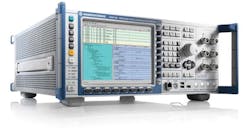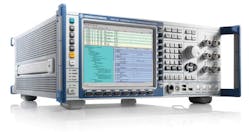The performance-testing capacity of LTE-Advanced (LTE-A) multimode chipsets, devices, and base stations has been increased in a move that will enable users to save as much as 150% in test tools expenditure compared to investing in multibox solutions. These are the claims behind a multilink enhancement to wireless test specialist Anite's Propsim channel emulator platform.
The company says the enhanced multilink emulation capacity in a Propsim F32 box eliminates the need to synchronize several emulator boxes—this speeds up the development and verification of new devices and base stations and users can create larger test scenarios in a lab environment, says the company. LTE-A device testing with large lab setups enable users to conduct more realistic performance testing, accurately testing the end-user experience in the live network.
This file type includes high resolution graphics and schematics when applicable.
Propsim F32 allows testing of new LTE-A features such as Carrier Aggregation, ICIC, and eICIC (enhanced Inter Cell Interference Coordination) using real-world scenarios for each user independently. It supports performance testing of four LTE devices and four LTE base station cells, or as many as 10 LTE devices connected to two base stations when conducting Carrier Aggregation or handover testing.
Collaboration Verification
Collaborative communication design work between Anite and HiSilicon, the Shenzhen, China-based producer of ARM SoCs, has resulted in the verification of Release 10 LTE-A protocols in a newly developed LTE-A chipset. This is an important move forward for LTE-A. One of the proclaimed advantages of LTE-A is its capability to exploit advanced topology networks; industry observers believe the next significant performance leap forward in wireless networks will come from making the most of such networks. In addition, LTE-A will also facilitate the use of wide bandwidths, as much as 100 MHz of the spectrum supporting very high data rates.
Anite maintains that features within its testing solutions have enabled the development of LTE-A products in line with market requirements and it was these solutions that were used to verify HiSilicon’s new Balong720 chipset, which is said to be the world’s first LTE Cat6 platform supporting 20 MHz + 20 MHz Carrier Aggregation. The Anite HiSilicon collaboration has also resulted in the verification of new 3GPP RAN5 LTE-A CA protocol conformance test cases, using Anite’s Conformance Toolset.
Importantly, more than half of all TD-LTE test case verification submissions to 3GPP RAN5 to date have been provided by Anite using the Hisilicon product.
Aggregation Verification
In another collaboration, German test specialists Rohde & Schwarz (R&S) and Samsung say they have achieved a first in verifying LTE-A uplink carrier aggregation. The companies have successfully tested and verified the Release 10 feature--uplink carrier aggregation. They used a Samsung internal test device with a Samsung SHANNON300 modem chipset as the device under test (DUT) and tested it with an LTE-A-ready R&S CMW500 wideband radio communication tester (see photo).
The companies reached a significant milestone in the commercial implementation of LTE-A by successfully verifying uplink carrier aggregation in the real form factor. The tested Samsung DUT, a 6.3-in. real-form-factor test device, supports two transmissions with a single SHANNON300 baseband chipset, making the SHANNON300 the world’s first LTE-A ASIC chipset to verify uplink carrier aggregation.
However, commercial devices with two transmission antennas are still a design challenge. In the future, uplink carrier aggregation and uplink multiple-input-multiple-output (MIMO) technology will be required for the high throughput of wireless Internet communication like multimedia upload to cloud servers. R&S claims the CMW500 is the first test platform that offers both Release 10 reference implementation for downlink carrier aggregation and also a verified implementation to test uplink carrier aggregation in LTE-FDD.
This is important because it allows designers in the mobile device market to perform protocol and performance tests on chipsets and devices supporting LTE-A uplink carrier aggregation. The system can test handsets in all bands and bandwidth combinations defined by 3GPP. The throughput in downlink and uplink modes can be verified by establishing real end-to-end data connections to the built-in IP servers, no matter what the handset is using, TD-LTE or LTE-FDD.
This file type includes high resolution graphics and schematics when applicable.


